Ho Chi Minh City
Located in the south of the country, approximately 60 kilometers from the coast of the South China Sea and 1,720 kilometers south of. Population – more than 7 million 500 thousand people (2011).
In the distant past, Ho Chi Minh City was a small Cambodian fishing village known as Prey Nokor, inhabited by Khmer people who lived in this area several centuries before the arrival of the Vietnamese.
By the early 17th century, Prey Nokor was an important Khmer trading port. During this period, Vietnamese began to actively settle here (including refugees fleeing civil wars in Vietnam), as a result of which the Khmers found themselves almost isolated from their brothers in Cambodia and became a minority.
Cambodia was weakened by the war with Thailand, and therefore was unable to prevent these processes, as a result of which it lost this region, and with it access to the South China Sea and an important trading port.
After the conquest of this area by the Vietnamese, the city was renamed Saigon (after the name of the river on which it is located).
From 1887 to 1901, Saigon was the capital of the French colony of French Indochina, and from 1955 to 1975, the capital of South Vietnam.
In 1976, after the unification of the country and the creation of the Socialist Republic of Vietnam, the city was renamed Ho Chi Minh City (in honor of the 1st president of the country, Ho Chi Minh).
Today it is the largest city in Vietnam by population, its most important economic and industrial center, as well as the country's largest transport hub and a popular tourist center.
A variety of museums and theatres, one of the oldest zoos in the world, the world-famous Cu Chi Tunnels and vibrant nightlife, and a historic city center lined with elegant wide boulevards and French colonial buildings are Ho Chi Minh City's top attractions.
Climate in Ho Chi Minh City
Ho Chi Minh City Climate- tropical, with two clearly defined seasons: wet (from May to November) and dry (from December to April).
The average annual air temperature is +27…+29°С. Average air humidity is about 75%.
The rainiest months are June, July, August, September, October.
The driest months are January, February, March.
The hottest months are March, April, March (temperatures can rise from +34..+38°С)
The best time to visit Ho Chi Minh City is from December to March.
Last changes: 03.11.2012Transport Ho Chi Minh City
Taxi
Taxi is the most convenient way for tourists to travel around Ho Chi Minh City, and is very modest in price compared to other major cities in the world. Taxi fares are not regulated by the city authorities, so they may vary from company to company. On average, the fee is 12 to 15 thousand dong + the same landing fee.
There are many drivers who are dishonest towards tourists, so either agree on the fare in advance by writing it down on paper with all zeros, or make sure that the driver turns on the meter before the trip.
It is better to use the services of reputable taxi companies than private ones. We also recommend writing the name and address of your destination in Vietnamese (ask at the hotel reception) to show the taxi driver, since many of them do not speak English well.
Buses
There are about 130 bus routes throughout Ho Chi Minh City, many of which pass by all the main attractions of the city especially for tourists. The buses are clean, comfortable and inexpensive. The fare is about 3,000 dong per trip, paid directly on the bus.
Water transport
A good opportunity to enjoy the beauty of Ho Chi Minh City is to rent a speedboat or motor boat. You can charter a boat for about 10-30 USD per hour at the Bach Dang pier or through a specialized company such as Saigon River Express.
Last changes: 10/23/2012Sights of Ho Chi Minh City
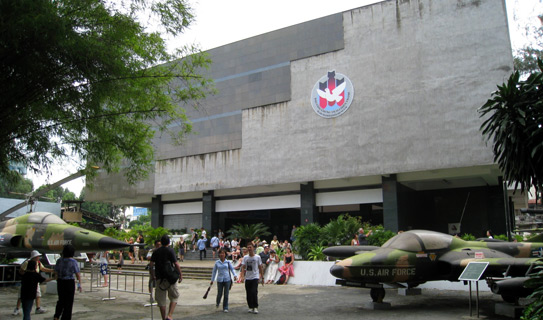
War Remnants Museum (Bảo tàng chứng tích chiến tranh)- was opened in 1975, with the goal of telling the world about American war crimes and the genocide of the Vietnamese people during the Vietnam War.
The museum exhibits many artifacts from that terrible period for Vietnam, including captured military equipment, numerous photographs of children and women killed by the Americans, as well as a guillotine used to execute prisoners and vessels with fruits preserved in alcohol that had undergone mutations due to toxic substances used The US Army persecuted the Vietnamese.
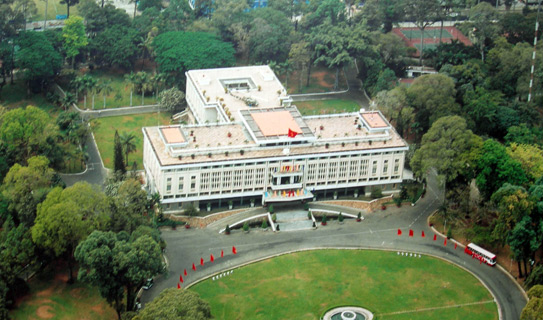
Reunification Palace (Hội trường Thống Nhất), formerly known as Palace of Independence– one of the main attractions of Ho Chi Minh City.
The current building of the palace was founded on July 1, 1962, on the site of a demolished stone palace built by the French colonialists in 1868 and badly damaged during the bombing of February 27, 1962.
Initially, under the French, the palace was the residence of the Governor-General of French Indochina, then it was called the “Palace of Independence” and it housed the government of South Vietnam, as well as the chambers of the last South Vietnamese president, Nguyen Van Thieu.
On April 30, 1975, a North Vietnamese army tank drove through the gates of the Palace of Independence, marking the victory of the communists.
Soon an agreement was concluded here to unite the North and South into a single country, and the building received the new name “Reunification Palace”.
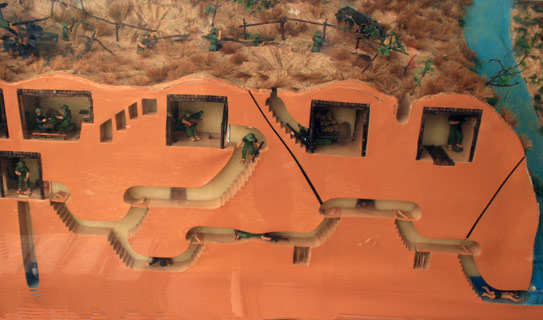
Cu Chi Tunnels (Địa đạo Củ Chi) or Ku-Ti Tunnels- a system of underground tunnels located approximately 40 kilometers northwest of Ho Chi Minh City, and used by the Viet Cong during the Vietnam War.
The network of tunnels, with a total length of about 200 kilometers, included numerous secret entrances and multi-level passages (about 70 cm wide, 90 cm high, 3 to 12 meters deep), as well as underground warehouses, living quarters and hospitals.
The Cu Chi Tunnels allowed the guerrillas to control a vast rural area near Saigon and launch covert attacks on the Americans. It was extremely difficult for tall American soldiers to penetrate these labyrinths, and those who managed to descend encountered numerous traps, so that only a few returned from there alive and unharmed.
To combat the tunnels, the Americans used spraying of toxic substances, which caused large-scale chemical contamination of soil and water, and they were also bombed.
The Vietnamese government has preserved about 120 kilometers of the Cu Chi tunnels to this day and turned them into a memorial park. Currently, this is one of the main attractions of South Vietnam, providing a unique opportunity to experience the underground life of the Vietnamese partisans.
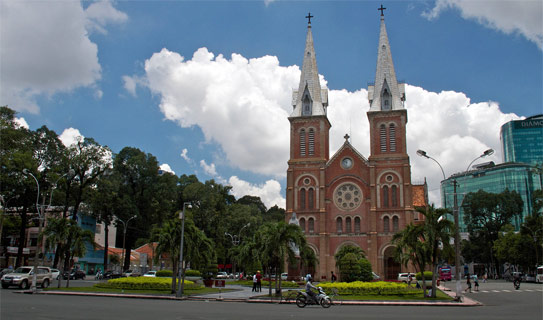
Notre Dame Cathedral (Nhà thờ Đức Bà Sài Gòn)– located in the center of Ho Chi Minh City on Paris Commune Square and is one of the main attractions of the city.
It was built by French colonists between 1887 and 1880. For the construction of the building, many materials were brought specially from France, including red brick - it was brought from Marseille.
The length of the building is 133 meters, the width is about 35 m. The height of each of the two bell towers is 57.6 m.
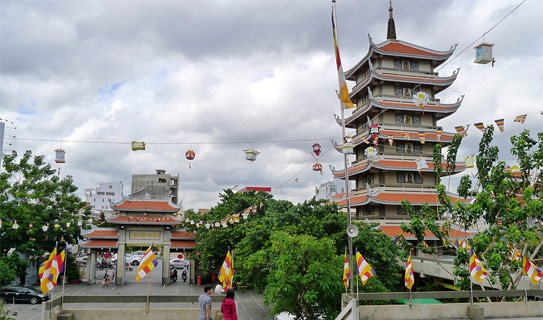
Vinh Nghiem Pagoda (Chùa Vĩnh Nghiêm) is the first temple in Vietnam built in the style of traditional Buddhist architecture, but using materials made using modern technologies. Construction lasted from 1964 to 1971.
On the territory of this large temple complex there are several buildings, the most spectacular of which is a forty-meter seven-story tower, considered the most complex and tallest stone tower in Vietnam.
Vinh Nghiem Temple is open to the public, including tourists: you can buy souvenirs and books here.
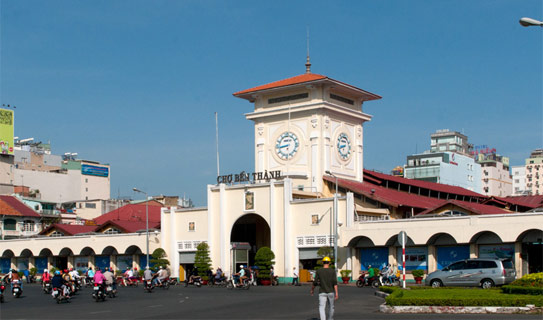
Ben Thanh Market (chợ Bến Thành)- one of the symbols of Ho Chi Minh City, and one of its popular attractions.
The market has existed on this site since the beginning of the 19th century, but as a result of fires and wars it was rebuilt several times. To this day, only the main tower with a bell tower and a clock, built in 1914, has survived from the old market.
Today the market complex consists of 4 buildings connected by a passage. Here you can buy almost everything - from spices and products to souvenirs, clothes and expensive silk.

– 68-storey skyscraper located in the central area of Ho Chi Minh City. Its height is 262.5 m.
There is a helipad on the 50th floor of the building, and on the 47th floor there is the Saigon Skydeck, which offers a magnificent 360-degree panorama of the city.
Last changes: 10/23/2012Parks and zoos in Ho Chi Minh City
Saigon Zoo (Thảo Cầm Viên Sài Gòn) is one of the oldest zoos in the world and the largest zoo in Vietnam. It was founded in 1864 by French colonialists, who founded a botanical garden for growing exotic plants and a small zoo on an area of 12 hectares.
In 1865, the park area was increased to 20 hectares, and in 1869 the Botanical Garden was opened to the public.
After the unification of Vietnam, the botanical garden was renamed the Saigon Zoo, and it began to actively develop as a zoo and botanical garden.
Now this large, well-kept park is home to more than 1,830 plants, including more than 20 species of orchids and a large collection of cacti, as well as more than 590 animals and birds.
Dam Shen Park (Công viên Văn hoá Đầm Sen) is the largest amusement park in Ho Chi Minh City, located on an area of about 50 hectares, of which 20% is occupied by lakes and ponds.
The territory of this cultural and entertainment complex is divided into 30 areas, in which, in addition to lakes, gardens and park areas, there are many different attractions, a sports center, a water park, a laser musical theater and much more.
Xoi Tien Amusement Park (Khu du lịch Văn hóa Suối Tiên) is a theme park in Ho Chi Minh City that illustrates the history and legends of Vietnam.
On the territory of the park complex, in addition to lush gardens, attractions, a water park, an aquarium and a crocodile farm with a huge artificial lake, there is also an artificial beach, a seawater pool, a dinosaur garden, a dragon palace, an alley of fountains and operating temples.
Choi Tien Park website –
